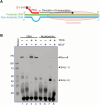Structural insights into promoter-proximal pausing of RNA polymerase II at +1 nucleosome
- PMID: 40043114
- PMCID: PMC11881899
- DOI: 10.1126/sciadv.adu0577
Structural insights into promoter-proximal pausing of RNA polymerase II at +1 nucleosome
Abstract
The metazoan transcription elongation complex (EC) of RNA polymerase II (RNAPII) generally stalls between the transcription start site and the first (+1) nucleosome. This promoter-proximal pausing involves negative elongation factor (NELF), 5,6-dichloro-1-β-d-ribobenzimidazole sensitivity-inducing factor (DSIF), and transcription elongation factor IIS (TFIIS) and is critical for subsequent productive transcription elongation. However, the detailed pausing mechanism and the involvement of the +1 nucleosome remain enigmatic. Here, we report cryo-electron microscopy structures of ECs stalled on nucleosomal DNA. In the absence of TFIIS, the EC is backtracked/arrested due to conflicts between NELF and the nucleosome. We identified two alternative binding modes of NELF, one of which reveals a critical contact with the downstream DNA through the conserved NELF-E basic helix. Upon binding with TFIIS, the EC progressed to the nucleosome to establish a paused EC with a partially unwrapped nucleosome. This paused EC strongly restricts EC progression further downstream. These structures illuminate the mechanism of RNAPII pausing/stalling at the +1 nucleosome.
Figures





References
-
- Gilmour D. S., Promoter proximal pausing on genes in metazoans. Chromosoma 118, 1–10 (2009). - PubMed
MeSH terms
Substances
LinkOut - more resources
Full Text Sources
Miscellaneous

